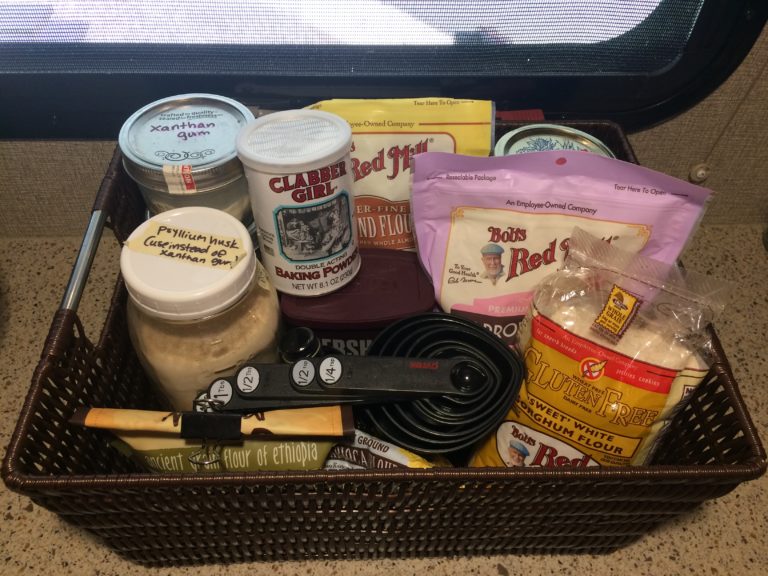Now you can follow Gluten-Free RV on Instagram for gems like this one:

Now you can follow Gluten-Free RV on Instagram for gems like this one:


Apps come and go all the time, and I think “favorite apps” lists are always like a snapshot in time. So here is a snapshot of our 10 favorite apps for August 2019, in no particular order:

When I realized it was going to be impossible to avoid gluten contamination if I lived with a gluten-eater, we immediately decided to make the whole house gluten-free.
I wish I could say a mixed-gluten kitchen was easier in a sticks-and-bricks home, but our apartment kitchen at the time was a little smaller than our RV’s kitchen, so that’s not true. The fact is, it’s extremely difficult to maintain a mixed kitchen, and impossible for us personally. So in preparation for a very a deep cleaning, we sorted everything in the kitchen to decide what could stay and what must go.
Maybe this post will help you if you find yourself in a similar situation, following a celiac diagnosis or eliminating gluten for other health reasons.
The medicine cabinet in our RV was generously sized (in our opinion), but it only had one shelf. There was a lot of wasted space. While we could have stored about 16 super-tall cans of 80’s Aqua Net, we’ve both outgrown that phase and our toiletries are a bit smaller these days. The cabinet itself is made of a light ¼ inch plywood, so it is not a good base with which to attach a shelf. However, I did this, I wanted to avoid visible screws. I chose some light hardwood lumber that could be stained to closely match the rest of the cabinet. Rather than installing standard shelf supports (which would likely require visible screws), I made two legs and used double faced tape to attach them to the inside of the lower shelf in order to support my new shelf. I cut and stained the new shelf to …
As we continue our quest for space optimization, we discovered some wasted space in the cabinet below the sink. Only the top half of the total cabinet space was usable as a cabinet when we bought it. The lower half of the space was closed off with a panel, in order to hide the plumbing connections and electrical runs. The area below the sink was opened for a previous project where I found myself tracking down a water leak. The space was closed off with a ¼ inch plywood panel to protect the water lines, drain, and some electrical feeds. When repairing the leak, I realized this area still had quite a bit of usable space, if I made a few modifications. My plan was to install a sub-floor in the cabinet and close off the areas with the water and electrical feeds using floating walls. I started by adding …
Shortly after we moved in, we started noticing water on the ground under the dump valve for the black tank and one of the gray tanks. Thankfully, the water appeared to be either fresh water or gray water! But it was a concern and needed fixing. Our unit has an all-weather sealed underbelly, so the water leaking could have been coming from any number of places and traveling along the underbelly to the drain valve area. We were really concerned, because water can do a lot of damage when the leaks are not addressed quickly. During the course of troubleshooting, we noticed the leak was the worst when the bathroom gray tank was close to full. I made a small incision in the corrugated plastic liner covering the underbelly to dry it out and get a better look at the problem. I could see the bottom of the gray tank, …
This post was originally published on The Whisker Shop’s blog with the title Helping Cats Live Large in Small Homes, and we’ve used this philosophy for “cattifying” our RV home, too. If you lack the square footage for elaborate cat furniture, there are plenty of ways to help your cat branch out (and up), and make you feel like he’s got more room than you. Tip #1: Think vertically! This is really the best way to maximize a cat’s space. Adding shelves, or rearranging stuff on existing shelves to make room for cats, is like a cat magnet for most cats. Keep in mind the size and age of your cats: smaller or older cats may need additional shelves or a chair moved so they can get on and off the shelf safely. Make sure the shelves can hold your cats’ weight and the force of their jump, to avoid …
Two of our cats are brothers we rescued at 5 weeks old. They’re now 5 years old, and still a handful. They hate being in hard-sided carriers with a passion. But on our last pre-RV relocation with a car full of stuff and 5 cats, they destroyed their soft-sided carrier before we even left our neighborhood. We ended up stopping at a pet store on our way out of town to buy two hard-sided carriers to contain them for the 600-mile trip. But we’re trying to make RV life easier on them, and we’re confident we can get them comfortable in the truck if we’re patient and creative. So a couple weeks ago, we bought a Pet Gear Soft Crate for the boys and another for our two girls (who are perfect angels on the road), and set it up for the boys to get used to having it around. …
Finding gluten-free food on the road can be tough. This is not a post about finding gluten-free restaurants, or about all the magical gluten-free dining experiences a traveler with celiac disease might find if only they were brave enough or bold enough. I am a super sensitive celiac. I am more sensitive than the average celiac, and it takes me longer to bounce back than many of my celiac peers. Once, I was glutened so badly by a careless restaurant that it took me over a year to feel “normal” again. Consequently, we don’t eat out much. So this is a post about where to find gluten-free groceries while traveling. Even before RV life, when we traveled, we brought a suitcase for our clothes and a suitcase for our food. (The food suitcase was usually bigger.) RV travel has made eating on the road MUCH easier and simpler, but there’s …